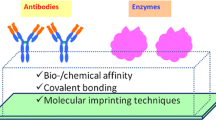Abstract
The glass bead is a new biochip support material for immobilization biomolecules, due to its independence and convenient rearrangement. In order to optimize the immobilization efficiency of oligonucleotides onto glass beads and obtain the highest hybridization efficiency, three commonly used coupling strategies have been studied for covalently attaching oligonucleotides onto large glass beads. Glass beads with 250 μm diameter were amino-silaned with 2% 3-aminopropyltrimethoxysilane (APTMS) and then reacted separately with glutaraldehyde, succinic anhydride and 1,4-phenylene diisothiocyanate (PDITC) to derive CHO beads, COOH beads and isothiocyanate-modified beads (NCS-Beads) accordingly. Afterwards, amino-terminal oligonucleotides were covalently attached onto the surface of beads achieved by three strategies mentioned above. The immobilization efficiency were studied to compare the three strategies, which turned out 2.55 × 1013 probes/cm2 for CHO-Beads, 3.21 × 1013 probes/cm2 for COOH beads and 6.68 × 1013 probes/cm2 for NCS beads. It meant that the immobilization efficiency based on NCS beads was most acceptable. And the method, developed by attaching amino-terminal oligonucleotides onto these cyanate active beads, could be regarded as an efficient one for immobilizing oligonucleotides onto a solid surface. Moreover, in this paper, the hybridization properties of NCS bead-based oligonucleotides have been studied by employing Cy5-tagged complementary oligonucleotides. It was found that the high probe density NCS beads led to low hybridization efficiency possibly due to the existence of steric crowding. In addition, the equilibrium binding constant K A was determined by employing Langmuir isotherm model, which was 7.0 × 106 M−1 for NCS beads with the density of 6.7 × 1013 probes/cm2. Furthermore, it only took 60 min to reach hybridization equilibrium. These large microspheres (>100 μm) can be employed in the mesofluidic systems for automated heterogeneous assays.






Similar content being viewed by others
References
Lytton-Jean, A. K. R., Han, M. S., & Mirkin, C. A. (2007). Analytical Chemistry, 79, 6037–6041.
Robelek, R., Niu, L., Schmid, E. L., & Knoll, W. (2004). Analytical Chemistry, 76, 6160–6165.
Sakata, T., Maruyama, S., Ueda, A., Otsuka, H., & Miyahara, Y. (2007). Langmuir, 23, 2269–2272.
Wu, L., Thompson, D. K., Liu, X., Fields, M. W., Bagwell, C. E., Tiedje, J. M., et al. (2004). Environmental Science & Technology, 38, 6775–6782.
Kohara, Y., Noda, H., Okano, K., & Kambara, H. (2002). Nucleic Acids Research, 30, e87.
Lenigk, R., Carles, M., Ip, N. Y., & Sucher, N. J. (2001). Langmuir, 17, 2497–2501.
Edman, C. F., Raymond, D. E., Wu, D. J., Tu, E., Sosnowski, R. G., Butler, W. F., et al. (1997). Nucleic Acids Research, 25, 4907–4914.
Chrisey, L. A., Lee, G. U., & O’Ferrall, C. E. (1996). Nucleic Acids Research, 24, 3031–3039.
Joos, B., Kuster, H., & Cone, R. (1997). Analytical Biochemistry, 247, 96–101.
Rasmussen, S. R., Larsen, M. R., & Rasmussen, S. (1991). Analytical Biochemistry, 198, 138–142.
Ghosh, S. S., & Musso, G. F. (1987). Nucleic Acids Research, 15, 5353–5372.
Guo, Z., Guilfoyle, R. A., Thiel, A. J., Wang, R., & Smith, L. M. (1994). Nucleic Acids Research, 22, 5456–5465.
Schena, M., Shalon, D., Heller, R., Chai, A., Brown, P., & Davis, R. (1996). Proceedings of the National Academy of Sciences, 93, 10614–10619.
Lamture, J. B., Beattie, K. L., Burke, B. E., Eggero, H. D., Ehrlich, D. J., Fowler, R., et al. (1994). Nucleic Acids Research, 22, 2121–2125.
Charles, P. T., Vora, G. J., Andreadis, J. D., Fortney, A. J., Meador, C. E., Dulcey, C. S., et al. (2003). Langmuir, 19, 1586–1591.
Chrisey, L. A., Lee, G. U., & Ferrall, E. O. (1996). Nucleic Acids Research, 24, 3031–3039.
Rogers, Y. H., Jiang-Baucom, P., Huang, Z. J., Bogdanov, V., Anderson, S., & Boyce-Jacino, M. T. (1999). Analytical Biochemistry, 266, 23–30.
Smith, S. B., Finzi, L., & Bustamante, C. (1992). Science, 258, 1122–1126.
Arlinghaus, H. F., Kwoka, M. N., Guo, X.-Q., & Jacobson, K. B. (1997). Analytical Chemistry, 69, 1510–1517.
Seong, G. H., Zhan, W., & Crooks, R. M. (2002). Analytical Chemistry, 74, 3372–3377.
Liu, X. D., Tokura, S., Haruki, M., Nishi, N., & Sakairi, N. (2002). Carbohydrate Polymers, 49, 103–108.
Wu, S. W., Liu, B., & Li, S. (2005). International Journal of Biological Macromolecules, 37, 263–267.
Monaghan, P. B., McCarney, K. M., Ricketts, A., Littleford, R. E., Docherty, F., Smith, W. E., et al. (2007). Analytical Chemistry, 79, 2844–2849.
Janolino, V. G., & Swaisgood, H. E. (1982). Biotechnology and Bioengineering, 24, 1069–1080.
Fixe, F., Dufva, M., Telleman, P., & Christensen, C. B. V. (2004). Nucleic Acids Research, 32, e9.
Nelson, B. P., Grimsrud, T. E., Liles, M. R., Goodman, R. M., & Corn, R. M. (2001). Analytical Chemistry, 73, 1–7.
Okahata, Y., Kawase, M., Niikura, K., Ohtake, F., Furusawa, H., & Ebara, Y. (1998). Analytical Chemistry, 70, 1288–1296.
Nolan, J. P., & Sklar, L. A. (2002). Trends in Biotechnology, 20, 9–12.
Acknowledgement
This work was funded in part by SHUGUANG Program of Shanghai (06SG32), the Program for New Century Excellent Talents in University (Grant NCET-07–0287), and the National Natural Science Foundation of China (20627005).
Author information
Authors and Affiliations
Corresponding author
Rights and permissions
About this article
Cite this article
Sheng, H., Ye, BC. Different Strategies of Covalent Attachment of Oligonucleotide Probe onto Glass Beads and the Hybridization Properties. Appl Biochem Biotechnol 152, 54–65 (2009). https://doi.org/10.1007/s12010-008-8245-9
Received:
Accepted:
Published:
Issue Date:
DOI: https://doi.org/10.1007/s12010-008-8245-9




